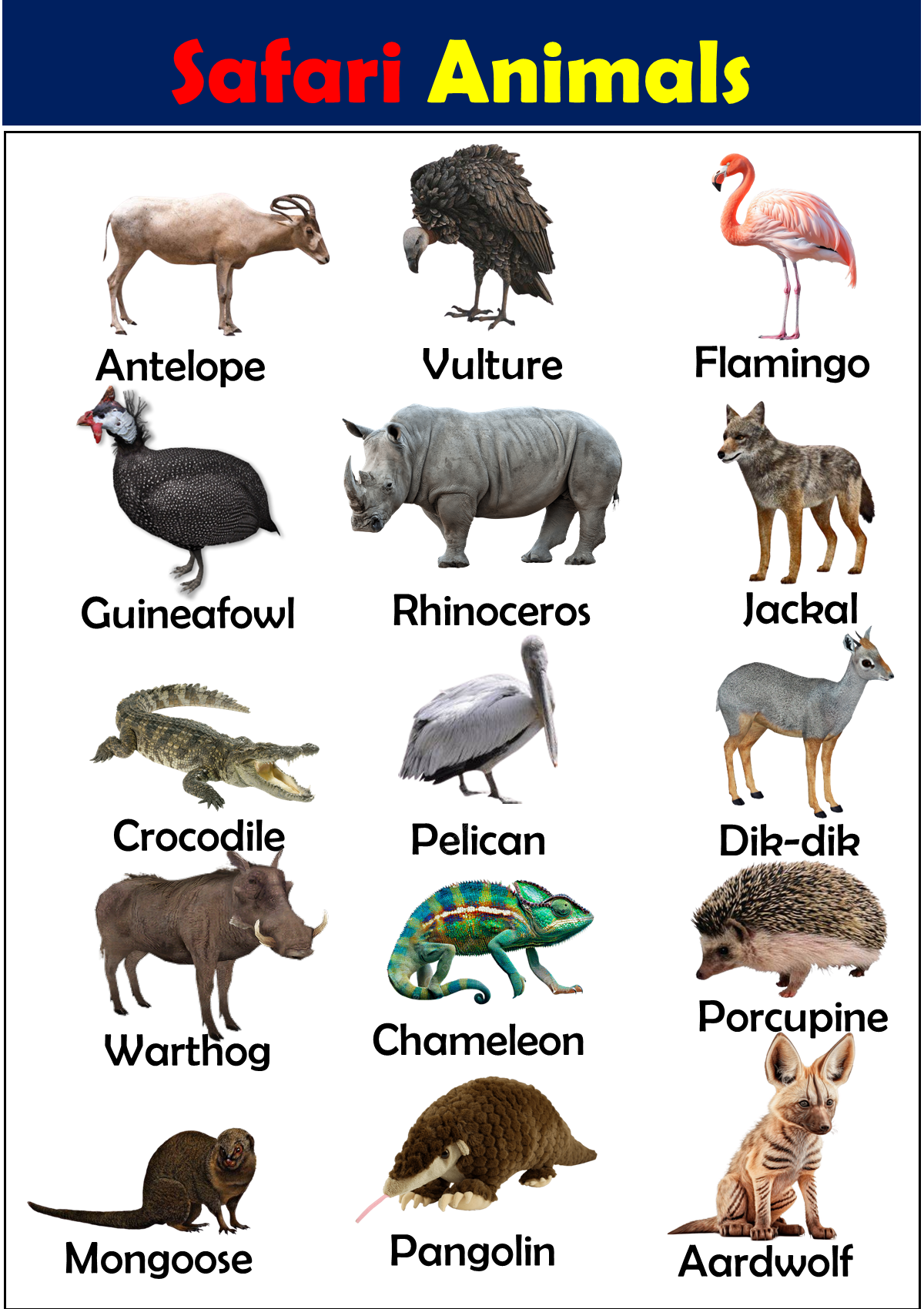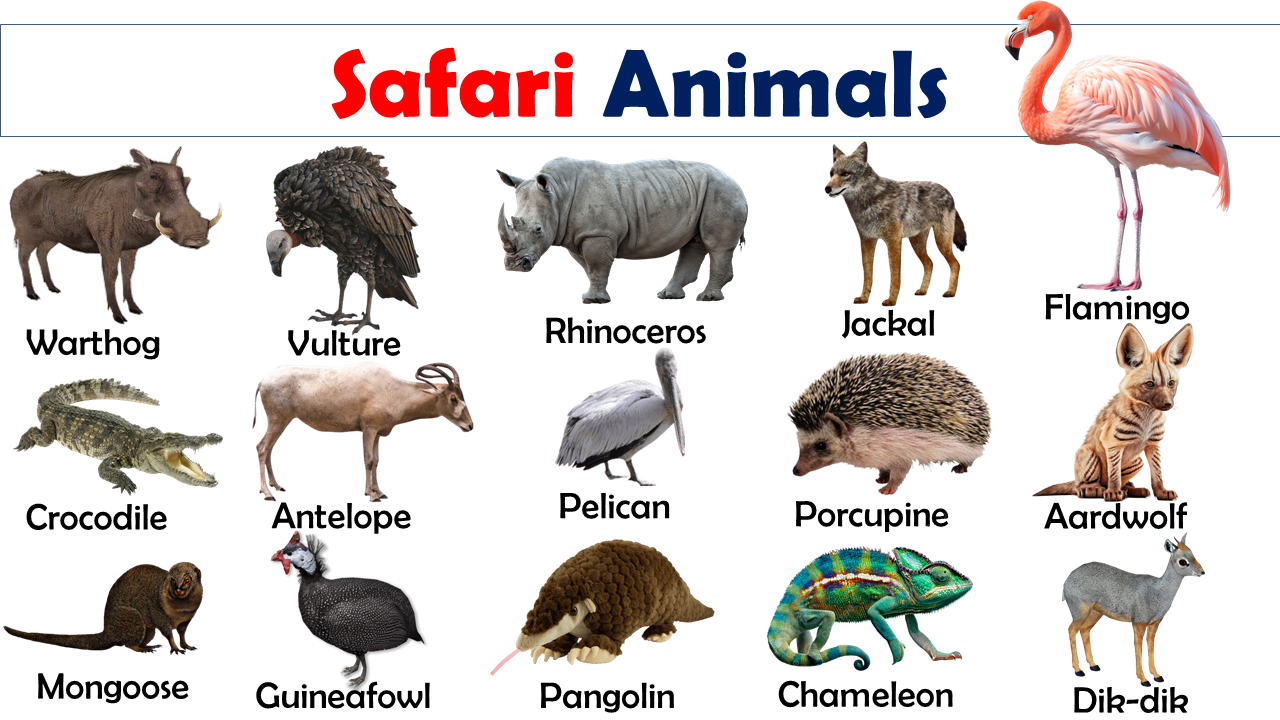Going on a safari is like stepping into a giant outdoor adventure, where you can see some of the world’s most famous wild animals in their natural home. In this blog post, we’ll discover the incredible animals you might see on a safari, like lions, elephants, and giraffes. These animals roam freely in the vast open spaces of places like Africa’s savannas. You’ll learn about what they eat, how they live, and the different ways they survive and thrive. Get ready to explore the exciting world of safari animals and learn new English words along the way!
What are Safari Animals?
Safari animals typically refer to the wildlife commonly observed on safaris in Africa, where visitors explore natural habitats to witness a variety of mammals, birds, reptiles, and more in their natural environments. These animals often include large and charismatic megafauna, many of which are iconic to African savannahs and grasslands, attracting wildlife enthusiasts and photographers from around the world.
List of Safari Animals
- African Elephant
- Lion
- Cheetah
- Giraffe
- Hippopotamus
- Rhinoceros
- Zebra
- Wildebeest
- Hyena
- African Buffalo
- Warthog
- Antelope
- Meerkat
- Crocodile
- Ostrich
- Flamingo
- Leopard
- Gazelle
- Impala
- Kudu
- Eland
- Serval
- Caracal
- African Wild Dog
- Jackal
- Baboon
- Vulture
- Eagle
- Waterbuck
- Bushbaby
- Mongoose
- Dik-dik
- Hartebeest
- Topi
- Tsessebe
- Bongo
- Bushbuck
- Reedbuck
- Genet
- Pangolin
- Porcupine
- Python
- Monitor Lizard
- Chameleon
- African Fish Eagle
- Secretary Bird
- Marabou Stork
- Pelican
- Cobra
- Springbok
- African Penguin
- Orca (found along coastal safaris)
- Great White Shark (coastal waters)
- Honey Badger
- Aardvark
- Aardwolf
- Bat-eared Fox
- Ground Hornbill
- Sandgrouse
- Guineafowl
- African Harrier-Hawk
- Black-backed Jackal
- Nile Monitor
- Spotted Hyena
- Blue Wildebeest
- Red Lechwe
- Klipspringer
- Gemsbok
- Nyala
- Duiker
Explore More Animal Vocab:
Arctic Animals | Freshwater Animals | Farm Animals

Safari Animals Vocabulary and Their Facts
1. African Elephant
The African elephant is the largest land animal, distinguished by its massive body, large ears, and long trunk. These elephants are highly social and live in matriarchal herds. Their trunks have multiple functions, including breathing, smelling, touching, grasping, and sound production. Elephants play a critical ecological role by modifying their habitats, dispersing seeds, and creating pathways in dense forest areas.
2. Lion
Known as the “King of the Jungle,” lions are the only cats that live in groups, called prides. Predominantly found in Africa’s savannahs and grasslands, they cooperate to hunt and primarily feed on large ungulates. Lions are apex predators and play a key role in controlling the population of herbivores, thereby maintaining the balance within their ecosystem.
3. Cheetah
The cheetah is renowned for being the fastest land animal, capable of speeds up to 60-70 mph in short bursts covering distances up to 1,500 feet. They have a slender body built for speed, with non-retractable claws providing better grip during the chase. Cheetahs generally prey on smaller antelopes and contribute to maintaining natural animal population balances.
4. Giraffe
Giraffes are the tallest mammals on Earth, their height being an advantage in browsing leaves and buds in treetops inaccessible to other herbivores. They are known for their long necks, patchy coat patterns, and the unique ossicones on their heads. Giraffes play a crucial role in pollinating and dispersing the seeds of trees, aiding in ecological biodiversity.
5. Hippopotamus
Hippos are large, mostly herbivorous, semi-aquatic mammals, known for their barrel-shaped torsos, enormous mouths and teeth, nearly hairless bodies, and large size. They spend much of their time in water to cool off and hydrate their skin. Despite their plant-based diet, hippos are highly territorial and can be very aggressive if provoked.
6. Rhinoceros
Rhinoceroses, often simply called rhinos, have thick, protective skin and one or two horns on their snouts. They are known for their poor eyesight but acute senses of hearing and smell. Rhinos are critical for ecological balance, their feeding habits aiding in vegetation management and soil turnover.
7. Zebra
Zebras are known for their distinctive black and white stripes, unique to each individual. They are social animals, living in large herds that mingle with other grazers. Zebras are primarily grazers and can trek long distances to find suitable feeding grounds, playing an essential role in their ecosystems by triggering the growth of young shoots in pastures.
8. Wildebeest
Wildebeests, also known as gnus, are noted for their annual migration, one of the most spectacular wildlife events on Earth. They are robust animals, characterized by their strong build and distinctive horns. Their migration helps to shape the landscape and ensure a healthy balance in the savannah ecosystem.
9. Hyena
Hyenas are not just scavengers but also powerful hunters. They have complex social structures and communicate through distinct sounds. Known for their ‘laugh,’ these sounds are actually communication signals. Hyenas’ roles as both predator and scavenger help to keep ecosystems clean and control the spread of diseases by consuming dead and decaying matter.
10. African Buffalo
African buffalos, also known as Cape buffalos, are large, highly dangerous bovines known for their herd behavior and powerful build. They have a symbiotic relationship with many African birds such as the oxpecker, which feeds on the parasites found on their skin. Buffalos contribute to the ecosystem by grazing heavily, which helps maintain the savannah grasslands.
11. Warthog
Warthogs are recognizable by their curved tusks, large heads, and the ‘warts’ which are actually protective pads on their faces. They are primarily grazers and will kneel on their front knees to eat short grass. By borrowing dens from other animals or digging them, warthogs help aerate the soil and control insect populations.
12. Antelope
Antelopes are part of the bovid family and are known for their agility and speed, which are crucial for evading predators. They come in various sizes and shapes, from the tiny dik-dik to the large eland. As grazers and browsers, antelopes play a significant role in the health of savannah and forest ecosystems by maintaining plant growth and soil quality.
13. Meerkat
Meerkats are small burrowing animals, living in large underground networks with their extended families, known as “mobs” or “gangs.” Highly social, they take turns performing duties like lookouts for predators. Meerkats are insectivores and their diet helps control the population of insects.
14. Crocodile
Crocodiles are ancient reptiles with powerful jaws, sharp teeth, and a formidable strength. They are apex predators in their environments, playing a crucial role in maintaining the balance of river ecosystems. Their presence ensures that populations of aquatic and edge-of-water species are kept in check, contributing to overall biodiversity.
15. Ostrich
The ostrich is the world’s largest and heaviest bird, famous for its long neck, long legs, and the ability to run at speeds up to 60 km/h, which is helpful for escaping predators. Ostriches cannot fly, but they can use their powerful legs to kick as a defense mechanism. Their eating habits help spread plant seeds, aiding in habitat preservation.
16. Flamingo
Flamingos are instantly recognizable due to their striking pink feathers, long legs, and unique beak shape, which they use to filter-feed on algae, small crustaceans, and plankton. Their color comes from the carotenoid pigments in their diet. Flamingos often breed in large colonies, which helps protect against predators. Their feeding habits are essential for nutrient cycling in their habitats.
17. Leopard
Leopards are adaptable big cats known for their beautiful spotted fur, which provides camouflage in various environments, including the savannah and rainforests. They are solitary and nocturnal, preferring to ambush their prey from the trees. As apex predators, leopards help manage the populations of smaller mammals and maintain the health of the ecosystem.
18. Gazelle
Gazelles are slender, medium-sized antelopes noted for their graceful movements and the ability to reach high speeds, up to 60 miles per hour, to escape predators. They are a crucial part of the savannah ecosystem, feeding on grasses and leaves, which helps to maintain vegetation growth and soil health.
19. Impala
Impalas are medium-sized antelopes with sleek bodies and agile movements, famous for their ability to leap up to 10 feet in the air. They are important prey animals in the savannah, supporting populations of predators like lions and leopards. Impalas also play a key role in their habitat by grazing, which helps prevent overgrowth of vegetation.
20. Kudu
Kudus are one of the largest antelope species, recognizable by their long, spiraling horns and striped bodies. They are browsers, feeding on a variety of leaves and plants, which helps to control plant populations and ensure diverse plant growth, essential for maintaining a healthy ecosystem.
21. Eland
The eland is the largest of the antelope species, characterized by its slow pace and ability to jump over 2.5 meters from a standstill. Elands are significant seed dispersers, thanks to their diet of fruits and leaves, contributing to the regeneration of many plant species across the savannah.
22. Serval
The serval is a medium-sized African wild cat known for its long legs, large ears, and spotted coat. It specializes in catching rodents and other small animals, using its hearing to detect prey before pouncing. Servals help control the population of these small animals, which can become pests if not kept in check.
23. Caracal
Known for its distinctive tufted ears, the caracal is a robust and agile cat that preys on birds, rodents, and small mammals. It plays an important role in controlling overpopulations of these species, contributing to ecological balance. Caracals are solitary and elusive, making them one of the less frequently seen safari animals.
24. African Wild Dog
African wild dogs are highly social and efficient predators that hunt in packs. Known for their distinctive mottled fur and communal behavior, they have one of the highest hunting success rates of any predator. By preying on weak and sick animals, they help maintain healthy populations of their prey species.
25. Jackal
Jackals are opportunistic omnivores, feeding on small mammals, birds, and fruits. They often scavenge the remains of kills made by larger predators. Jackals are important for maintaining the ecosystem’s health by cleaning up waste and controlling rodent populations, which helps prevent disease spread.
26. Baboon
Baboons are large, highly intelligent, and social primates known for their ability to adapt to various environments. They live in large troops, governed by a complex hierarchy. Baboons are omnivores, eating a varied diet that helps to control insect populations and disperse seeds, which supports forest and savannah ecosystems.
27. Vulture
Vultures are crucial to African ecosystems as scavengers that consume dead animal matter, significantly reducing the spread of disease. They have a highly acidic stomach that allows them to safely digest carcasses infected with bacteria that would be lethal to other animals. This cleanup service helps keep the environment healthy and balanced.
28. Eagle
Eagles are powerful birds of prey, known for their keen eyesight and powerful talons. They play a vital role in the ecosystem by managing populations of medium-sized animals and rodents, which helps maintain ecological balance. Eagles are often seen as symbols of freedom and strength across cultures.
29. Waterbuck
Waterbucks are large antelopes known for the distinctive white ring on their rumps and their preference for habitats close to water sources. They are important grazers in their ecosystems, helping to keep aquatic vegetation in check, which supports the health of wetland areas and provides resources for other wildlife.
30. Bushbaby
Bushbabies, or galagos, are small, nocturnal primates with large eyes adapted to their night-time lifestyle. They are crucial for the pollination of night-blooming flowers and also disperse seeds through their fruit-based diet. Their ability to leap between trees also aids in maintaining the canopy’s integrity, providing pathways for other arboreal species.
